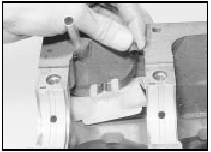Crankshaft and bearings - examination and renovation
1.8 litre (R2A type)
1 Examine the bearing surfaces of the
crankshaft for scratches or scoring and, using
a micrometer, check each journal and
crankpin for ovality. Where this is found to be
in excess of 0.0254 mm (0.001 in) the
crankshaft will have to be reground and
undersize bearings fitted.
2 Crankshaft regrinding should be carried out by a suitable engineering works, who will normally supply the matching undersize main and big-end shell bearings.
3 Note that undersize bearings may already have been fitted either in production or by a previous repairer. Check the markings on the backs of the old bearing shells, and if in doubt take them along when buying new ones.
4 If the crankshaft endfloat is more than the maximum specified amount, a new thrust bearing shell should be fitted to the centre main bearing.
5 An accurate method of determining bearing
wear is by the use of Plastigage. The
crankshaft is located in the main bearings
(and big-end bearings if necessary) and the
Plastigage filament located across the journal
which must be dry. The cap is then fitted and
the bolts/nuts tightened to the specified
torque. On removal of the cap the width of the
filament is checked with a plastic gauge and
1.8 litre (R2A type)
1 Examine the bearing surfaces of the
crankshaft for scratches or scoring and, using
a micrometer, check each journal and
crankpin for ovality. Where this is found to be
in excess of 0.0254 mm (0.001 in) the
crankshaft will have to be reground and
undersize bearings fitted.
2 Crankshaft regrinding should be carried out by a suitable engineering works, who will normally supply the matching undersize main and big-end shell bearings.
3 Note that undersize bearings may already have been fitted either in production or by a previous repairer. Check the markings on the backs of the old bearing shells, and if in doubt take them along when buying new ones.
4 If the crankshaft endfloat is more than the maximum specified amount, a new thrust bearing shell should be fitted to the centre main bearing.
5 An accurate method of determining bearing wear is by the use of Plastigage. The crankshaft is located in the main bearings (and big-end bearings if necessary) and the Plastigage filament located across the journal which must be dry. The cap is then fitted and the bolts/nuts tightened to the specified torque. On removal of the cap the width of the filament is checked with a plastic gauge and
Cylinder block and bores - examination and renovation
Refer to Section 36, Chapter 2, Part A but note that the crankcase ventilation baffle should be removed from its location at the rear of the cylinder block and cleaned if necessary (see illustration).

34.1 Removing the crankcase ventilation baffle
Initial start-up after overhaul or major repair
Refer to Section 37, Chapter 2, Part A.
See also:
General Repair Procedures
Whenever servicing, repair or overhaul work
is carried out on the car or its components, it
is necessary to observe the following
procedures and instructions. This will assist in
carrying out the ...
Thermostat - removal and refitting
1 Disconnect the battery negative lead.
2 Drain the cooling system.
3 Proceed as follows according to model:
SOHC models
4 Disconnect the radiator top hose and
expansion tank hose from the thermo ...
Handbrake cable - adjustment
Note: Where fitted, the adjuster locking pin
must be renewed on completion of
adjustment.
Conventional braking system
(except P100 models)
1 The handbrake cable is normally
self-adjusting in use ...
